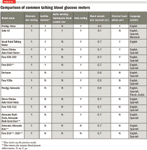Helping patients with diabetes and visual or manual impairment (part 1)
Learn about assistive devices and strategies to help improve care for these particular patients.
Approximately 26 million people in the United States have diabetes.1 Diabetes management can be extremely challenging when patients with diabetes also have major disabilities. Two common disabilities associated with diabetes are loss of vision and loss of dexterity.
Diabetes itself is the leading cause of severe vision loss or blindness among adults.1 The disease can also cause significant nerve damage, which can lead to loss of somatic sensation in both hands and feet. These physical disabilities can make it extremely challenging for patients to monitor blood glucose and administer insulin.
However, a variety of assistive devices and strategies are available to aid these patients. Knowledge of these devices and strategies will enable pharmacists to make appropriate recommendations and help patients gain control over these barriers to diabetes management. Part 1 of this 2-part article discusses adaptive strategies for patient self-monitoring of blood glucose.
There have been significant technologic advancements in the development of blood glucose meters for patients with partial or full loss of vision. Glucose meters with large, backlit display screens and numbers make results easier to read for patients with mild vision loss. These include the EasyMax Light, EasyGluco Plus, Fora G90, FreeStyle Lite, OneTouch Ultra2, OneTouch UltraSmart, Precision Xtra, ReliOn Ultima, Rightest GM550, and the various WaveSense meters.2
Glucose meters with test-strip port lights allow the patient to have a better view of the blood sample during testing. The FreeStyle Lite has both a backlight and a test-strip port light.
For patients with moderate to severe vision loss, the ideal blood glucose meter would have audio capability for all functions to allow truly independent operation.3 Although several audio-capable meters are on the market, they have significant differences in their ease of accessibility by visually impaired patients.
To help these patients select a meter, pharmacists can look for as many of the following features as possible: ability to speak the test result; ability to repeat audibly the current and previous results and times of each test; audible memory that delivers the 7-, 14-, and 28-day averages; audible settings menu; tactile buttons; auto-coding of test strips; an external headphone port (for privacy); and audible warnings for inadequate blood sample size, out-of-date test strip, temperature alert, and other error messages.

Unfortunately, not all glucose meters and their testing supplies are available in community pharmacies; some are available only by mail order.
Even with all of the audio capabilities available in these meters, patients with vision loss still must contend with the task of getting the blood onto the test strip. This process can be difficult even in some sighted patients, as an adequate sample size is needed to ensure an accurate reading.
Patients with vision loss may express concerns about wasting test strips because they cannot see if the blood sample size is too small, and more than one attempt may be necessary. With repeated practice, however, this seemingly daunting task can be accomplished with accuracy. The usual tips for obtaining an adequate fingerstick blood sample, such as warming the hands before testing to increase blood flow to the fingers, are just as valuable for patients with vision loss.